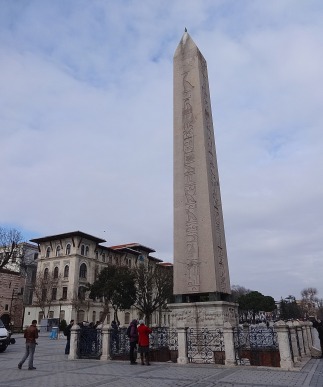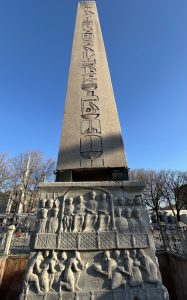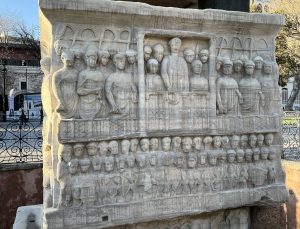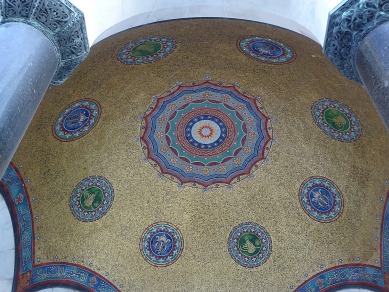Stadium for chariot races
Other name: Atmeydanı (Turkish)
Festival: Post-iftar stalls and celebrations during Ramazan
Once the venue for hotly contested Byzantine chariot races, the Hippodrome is just steps away from Ayasofya Square and the Sultanahmet tram stop. Many people probably wander up and down it without ever realising its historic significance especially since the road layout that used to follow the old racetrack has been made less obvious by a remodelling aimed at opening up the space in the centre.
To imagine how things would have been in the past you need to stand at the Sultanahmet end of the Hippodrome beside the German Fountain (Alman Çeşmesi) with its green-roofed dome. From here you can gaze down towards the building that houses the Rektorluk (administration offices) of Marmara University which sits just inside what was once the curved end of the racetrack. On either side of you the chariots would have pounded up and down with the crowd cheering on the riders from banked seating on either side.
In front of you what is now open space would have held the “spina“, the median strip for the racetrack which was adorned with all sorts of fine statuery. Today the only survivors are the two obelisks imported from Egypt and the slight remains of what was once a metal tripod supported by the bodies of three intertwined metal snakes. The Istanbul Archaeological Museum also contains the base of two monuments commemorating the charioteer, Porphyrius, that would once have stood on the spina; one was erected by the Blues, the other by the Greens, the two most popular chariot teams that attracted the sort of fanatical following today reserved for the Galatasaray, Fenerbahçe and Beşiktaş football teams.
In the 16th and 17th centuries the structures surrounding the Hippodrome were demolished to make space for Sultanahmet Cami (the Blue Mosque) and İbrahim Pasa’s Palace (now the Museum of Turkish and Islamic Arts). Later still the Hippodrome became an important administrative centre, home not just to the Rektorluk but also to the huge building that used to house the Kadastro, the department that dealt with local property transfers, and now houses the Ayasofya Tarihi Müzesi (Ayasofya History Museum).
 Around the Hippodrome
Around the Hippodrome
If you walk towards the Hippodrome from the Sultanahmet tramstop you will pass the slight remains of the palaces of two Byzantine nobles called Antiochus and Lausus. The frescoed Byzantine shrine of St Euphemia has recently been restored but has not yet opened to the public. If you turn right when you reach the Hippodrome you will walk past the Kadastro building whose imposing tiled facade was designed in 1909 by Vedat Tek in First National architectural style.
Continuing in the same direction you will pass İbrahim Paşa’s palace built in 1524 for the son-in-law and grand vizier of Sultan Süleyman the Magnificent. This fine stone building with its pretty little wooden balcony now houses the wonderful Museum of Turkish and Islamic Arts but is interesting in its own right as the last surviving privately owned early Ottoman mansion in the city.
Continuing round the end of the Hippodrome you will pass in front of the building that now houses the Rektorluk of Marmara University but which was originally designed as an art school in the 1890s by the Art Nouveau architect, Raimondo d’Aronco. Attached to it there was originally a small museum dedicated to the Janissary soldiers who had played such an important role in Ottoman history. Today this houses a small art gallery full of prints by Turkish artists as well as a room devoted to the memory of Cairo-born Ihap Hulusi Gorey (1898-1986), the man responsible for some of the finest examples of Turkish advertising materials. Sometimes there are also temporary exhibitions here which may spread out into the Rektorluk building and its small private hamam.
On the corner opposite the Rektorluk is an attractive wooden house designed by architect Arif Hikmet Koyunoğlu (1888-1982) in the 1930s for Recep Peker who was prime minister from 1946-47 . I was told that İsmet İnönü had lived in it for some time but have found no confirmation of this.
If you walk downhill beside the Rektorluk you will see, on the right, the remains of the Sphendone, the huge semi-circular wall that used to provide a support for the tiered seating in the Hippodrome. Once upon a time there were tunnels inside the wall that led to the different sections of seating just as in a modern football stadium but later the Sphendone was redesigned to serve as the local water depot. If you walk past on a Wednesday you will see a local street market taking place right beside these ancient remains.
Walking back along the far side of the Hippodrome towards Sultanahmet you will pass along the outside wall of the Blue Mosque until you reach the domed tomb of Sultan Ahmed I on the corner facing the German Fountain,
Monuments of the Hippodrome
 The most striking of the three monuments surviving from the spina is the granite Obelisk of Theodosius (Dikilitaş) brought to Constantinople from Thebes in Egypt where it had been carved with hieroglyphics in c 1450 BC. The obelisk – shorter now than it was originally – was erected on a double plinth which shows scenes of the Hippodrome in its heyday with the emperor watching a race from his private box before awarding a laurel wreath to the victor.
The most striking of the three monuments surviving from the spina is the granite Obelisk of Theodosius (Dikilitaş) brought to Constantinople from Thebes in Egypt where it had been carved with hieroglyphics in c 1450 BC. The obelisk – shorter now than it was originally – was erected on a double plinth which shows scenes of the Hippodrome in its heyday with the emperor watching a race from his private box before awarding a laurel wreath to the victor.
The so-called Serpentine Column (Yılanlı Sütün) is a twisted, broken metal column that was created to commemorate a Greek victory over the Persians in 478 (their shields were used to make the monument) and was erected in Delphi before being brought to Constantinople by Constantine the Great in c.330. The original column was topped with three snakes’ heads which held up a golden cauldron but only one of them still survives in the İstanbul Archaeological Museum.

The least interesting of the three is the rough-cut Knitted Obelisk (Örme Dikilitaş), which was probably also erected in the reign of Constantine the Great or Theodosius I, and was covered with bronze plates by Constantine VII Porphyrygenitus. Like so much else, the plates were lost to the Fourth Crusaders in 1204, leaving the obelisk without adornment.
The final monument in the Hippodrome has nothing to do with the spina. Kaiser Wilhelm’s Fountain was erected in 1898 to commemorate the visit of the Kaiser to Sultan Abdülhamid II. Designed by Max Spitta, it has the initials of both rulers woven into the golden mosaic lining the dome. It stands on the site of a tree where rebellious Janissaries are believed to have been hanged in 1826.
Sleeping
There are a few hotels in the narrow streets running off the Hippodrome, almost all of them boutique hotels which means small and charming but not especially cheap. Most have great views from their roof terraces.
Hotel Fehmi Bey This charming 27-room hotel is just round the corner from the Hippodrome, and offers a delightfully decorated lobby and a large roof terrace with predictably spectacular sea views. Üçler Sokak No. 3, Tel: 0212-638 9083
Alzer Hotel. Tel: 0212-516 6262
Hotel İbrahim Paşa. Tel: 0212-518 0395
Hotel Turkoman. Tel: 0212-516 2956
Transport info
The nearest tram stop is Sultanahmet.
Nearby areas
 Mosaic-covered interior of German Fountain with emblems of Sultan Abdülhamid II and Kaiser Wilhelm II
Mosaic-covered interior of German Fountain with emblems of Sultan Abdülhamid II and Kaiser Wilhelm II


